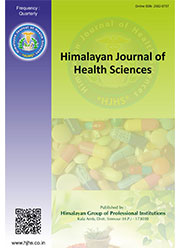A Pharmacognostic review of Liquorice: Pharmacological actions, Current uses and Future prospects
Abstract
Herbs used as medicines are one of the widely adopted treatment alternatives which is in effect since ancient times. Herbal drugs are of great importance to the population because of its ease of availability and the relief of having no side effects. Majority of the herbal drugs are possessed to have more than one pharmacological effect. One such classic example of well-known herbal drug is Liquorice which is commonly known as Sweet Wood or Mulethi. Liquorice is available in dried root or rhizome form and it is widely used as natural sweetener, expectorant and as a hepato-protectant. The herb is widely grown in Baluchistan, Spain and in certain parts of Himalayan region of India. There are various active chemical compounds of Liquorice which include saponins and flavonoids. The pharmacological actions of this drug are attributed to its major active chemical compound named Glycyrrhizin. Liquorice is also found to have specific anti-viral activity against certain viral cells. The current article focusses on the pharmacognostic review of Liquorice and its uses. The multiple pharmacological effects of this drug and the future prospects of using Liquorice in developing formulations have been discussed in detail.
References
2. Kunle Oluyemisi Folashade, Egharevba Henry Omoregie1, Ahmadu Peter Ochogu. Standardization of Herbal Medicines – A Review. International Journal of Biodiversity and Conversation. 2012 Mar;4(3):101-112.
3. Pastorino G, Cornara L, Soares S, Rodrigues F, Oliveira MBPP. Liquorice (Glycyrrhiza glabra): A phytochemical and pharmacological review. Phytotherapy Research. 2018 Aug 17;32(12):2323-2339.
4. Dr Kaveri V. Rasal et al. Pharmacognostic Study Of Glycyrrhiza glabra Linn- A Review. International Ayurvedic Medical Journal. 2016 Oct;4(10):3188-3193.
5. Sharma V, Katiyar A, Agrawal R.C. Glycyrrhiza glabra: Chemistry and Pharmacological Activity. Sweeteners - Reference Series in Phytochemistry. 2018:87-100.
6. ePharmacogonosy. Liquorice. 2012 Oct 04 [Internet]. Epharmacognosy; 2012[cited 2021 Mar 21] Available from:
http://www.epharmacognosy.com/2012/04/liquorice-synonyms-glycyrrhiza.html
7. Jalal Bayati Zadeh, Zahra Moradi Kor, Masoud Karimi Goftar. Licorice (Glycyrrhiza glabra Linn) As a Valuable Medicinal Plant. International Journal of Advanced Biological and Biomedical Research. 2013;1(10):1281-1288.
8. Khalid Hussain et al. A Review: Medicinal Importance of Glycyrrhiza glabra L. (Fabaceae Family). Global Journal of Pharmacology. 2014;8(1):8-13.
9. Swati P, Jyothi G, Shreya J, Vijay Danapur. Preliminary Phytochemical and Pharmacognostic Studies on a Well-known Medicinal Plant Glycyrrhiza glabra. International Journal of Pharmacognosy and Chinese Medicine. 2019 Dec 24;3(4):01-05.

This work is licensed under a Creative Commons Attribution-NonCommercial 4.0 International License.
The International Journal of Innovative Science & Technology affairs require a formal written transfer of copyright from the author(s) for each article published. We therefore ask you to complete and return this form, retaining a copy for your records. Your cooperation is essential and appreciated. Any delay will result in a delay in publication.
I/we have read and agree with the terms and conditions stated Page 2 of this agreement and I/we hereby confirm the transfer of all copyrights in and relating to the above-named manuscript, in all forms and media, now or hereafter known, to the International Journal of Drug Regulatory affairs, effective from the date stated below. I/we acknowledge that the IJDRA is relying on this agreement in publishing the above-named manuscript. However, this agreement will be null and void if the manuscript is not published in the IJIST.
Download link for COPYRIGHT FORM





